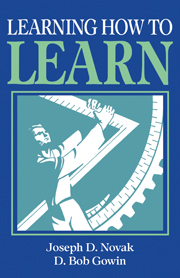Book contents
- Frontmatter
- Contents
- Foreword
- Preface
- Acknowledgments
- 1 Learning about learning
- 2 Concept mapping for meaningful learning
- 3 The Vee heuristic for understanding knowledge and knowledge production
- 4 New strategies for instructional planning
- 5 New strategies for evaluation: concept mapping
- 6 The use of the Vee for evaluation
- 7 The interview as an evaluation tool
- 8 Improving educational research
- Appendixes
- References
- Index
5 - New strategies for evaluation: concept mapping
Published online by Cambridge University Press: 05 June 2012
- Frontmatter
- Contents
- Foreword
- Preface
- Acknowledgments
- 1 Learning about learning
- 2 Concept mapping for meaningful learning
- 3 The Vee heuristic for understanding knowledge and knowledge production
- 4 New strategies for instructional planning
- 5 New strategies for evaluation: concept mapping
- 6 The use of the Vee for evaluation
- 7 The interview as an evaluation tool
- 8 Improving educational research
- Appendixes
- References
- Index
Summary
BROADENING THE RANGE OF EVALUATION PRACTICES
To most students and teachers, achievement testing (usually true-false, multiple-choice, or short answer paper-and-pencil exams) is synonymous with evaluation of learning. Although this kind of evaluation will continue to have a role to play in the appraisal of learning, we believe a much wider range of practicable evaluation techniques are needed if we are to encourage students to use more of their human potential – evaluation, like other educative events, should help them recognize the great power they have to make sense out of events or objects experienced in their world.
While it is true that much testing has been of poor quality and that improving the traditional forms would contribute to the enhancement of learning, even the most well-designed objective tests correlate with subsequent achievement only in the range of r = .2 to r = .7. When we square these correlation coefficients to obtain the common variance shared by these measures we get values of only .04 to .49, so that at best only about 50 percent of variation in measures of achievement is predicted by any achievement measure or set of measures given within a few months to a year or two. The situation is unfortunately even worse: Subsequent achievement is usually measured by the same kind of testing used to measure current achievement; if other ways of assessing future success, for instance, the number of patents awarded to engineers, are used, then die correlation between school performance and achievement falls to near zero!
- Type
- Chapter
- Information
- Learning How to Learn , pp. 93 - 108Publisher: Cambridge University PressPrint publication year: 1984
- 2
- Cited by



